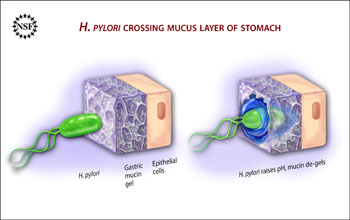Multimedia Gallery
H. pylori Crossing Mucus Layer
Contact with stomach acid keeps the mucin lining the epithelial cell layer in a spongy gel-like state. This consistency is impermeable to the bacterium Heliobacter pylori. However, the bacterium releases urease, which neutralizes the stomach acid and causes the mucin to liquefy, and the bacterium can swim right through it.
This discovery--showing how bacterium that causes human stomach ulcers uses a clever biochemical strategy to alter the physical properties of its environment, allowing it to move and survive and further colonize its host--changes a long-held paradigm about how bacteria move through soft gels.
This image accompanied NSF press release, "Uncovering the Secrets of Ulcer-causing Bacteria."
Credit: Zina Deretsky, National Science Foundation
Images and other media in the National Science Foundation Multimedia Gallery are available for use in print and electronic material by NSF employees, members of the media, university staff, teachers and the general public. All media in the gallery are intended for personal, educational and nonprofit/non-commercial use only.
Images credited to the National Science Foundation, a federal agency, are in the public domain. The images were created by employees of the United States Government as part of their official duties or prepared by contractors as "works for hire" for NSF. You may freely use NSF-credited images and, at your discretion, credit NSF with a "Courtesy: National Science Foundation" notation.
Additional information about general usage can be found in Conditions.
Also Available:
Download the high-resolution JPG version of the image. (706 KB)
Use your mouse to right-click (Mac users may need to Ctrl-click) the link above and choose the option that will save the file or target to your computer.

